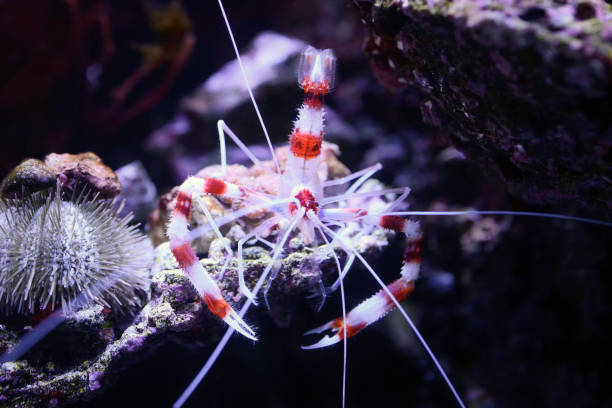ANIMAL: Banded Coral Shrimp Stenopus hispidus Type of Animal: Stenopodid Shrimp Habitat: Reefs, undercut mats of Thalassia rhizomes, buckets, tires, crevices, caves, rocky bottoms, sponge pockets, found at depths of 3.28-688.98 ft Location(s): W Atlantic from SE Canada to Argentina, Caribbean, Indo-Pacific, W Pacific from NE China to Australia/New Zealand/Easter Island Appearance: Very striking coloration, transparent ground color, banded red-white carapace (upper shell)/abdomen/3rd walking legs (pereiopods), other pereiopods/antennae white, banded area is spiny, females larger than males Food/Diet: Carrion, detritus, algae, fish parasites, injured tissue from fish, undesirable food particles from fish, marine worms, smaller shrimp, snails, small squid, small fish, zooplankton Status in Wild: Stable Lifestyle: Monogamous pairs Additional Info: Called: Male Female Young: Fry Group: Pair Gestation: 16 days Life Span: 2-3 years Body Length: Male: 2 in Female: 4 in Main predators are eels, triggerfish, groupers, snappers, & lionfish. These shrimp are cleaner shrimp, cleaning parasites/fungi/damaged tissue from many fish, including potential predators. Shrimp gets meal & fish gets nice cleaning making it mutualistic relationship. Use 3 pairs of claws for cleaning clients. These shrimp extremely territorial w/ fights often resulting in death. Can be active any time of day but more active at night. For most of year, females carry large mass of green eggs attached to ventral side of abdomen. To attract clients, they’ll dance in conspicuous spot & whip antennae from side to side. Besides cleaning fish, they’ll also clean corals. Mating occurs 12-48 hours after female molts, in which she’ll attract mate w/ pheromones. Peak time is 12-24 hours after molting. During courtship, male performs dance in front of mate. Eggs hatch 16 days after being laid. To become bigger, they need to molt exoskeleton every 3-8 weeks. Females only receptive to mates when recently molted. Larvae/fry go through 7-9 larval stages before metamorphosing into juveniles at around 4-7 months old. Maturity based on size rather than age. Fun Fact(s): Also known as Banded Cleaner Shrimp, Coral Banded Shrimp, Red-Banded Coral Shrimp, ‘Opae-Huna, Barber Pole Shrimp, Banded Boxing Shrimp, Clown Shrimp, Candy-Cane Shrimp, & Banded Prawn. Get boxing shrimp name due to large pincers on 3rd leg set often held erect, making it looks like it wants to fight.
